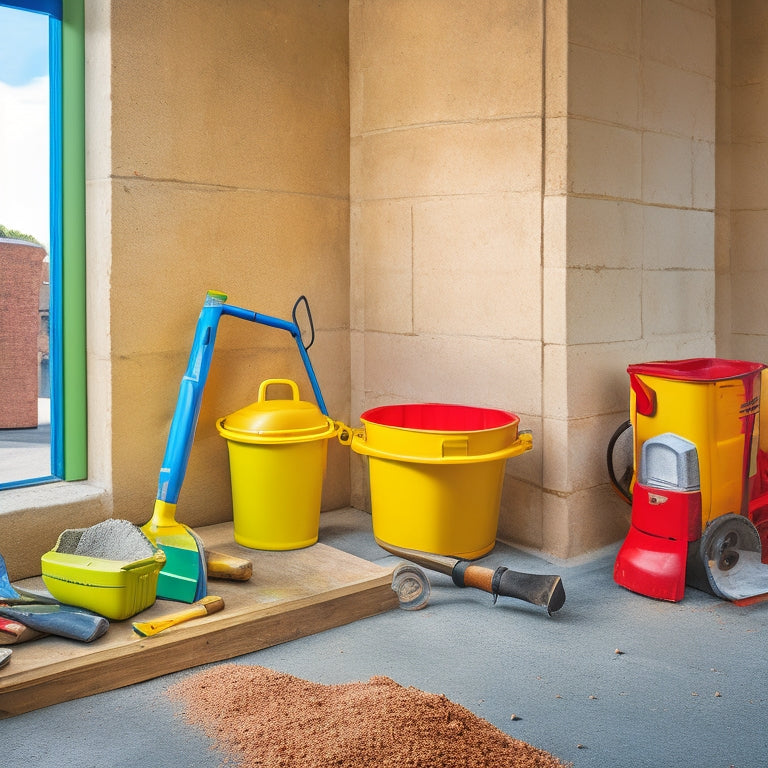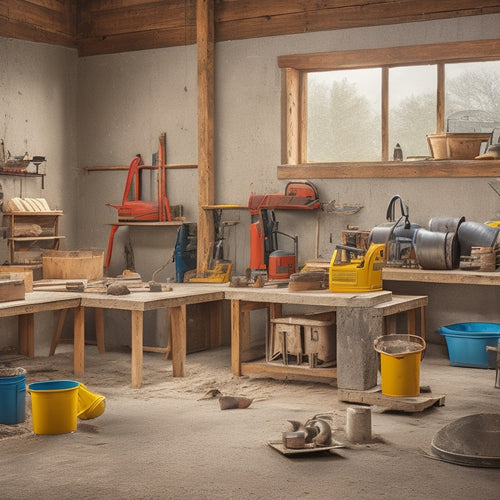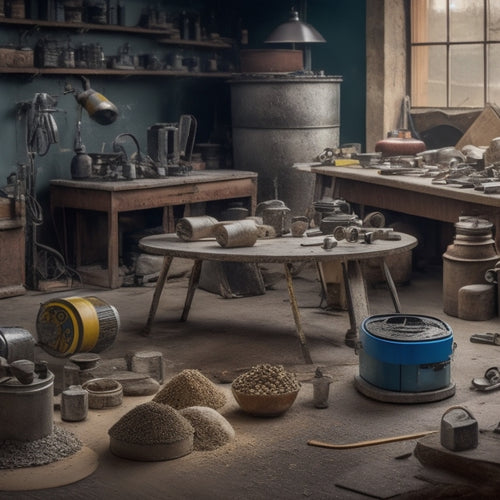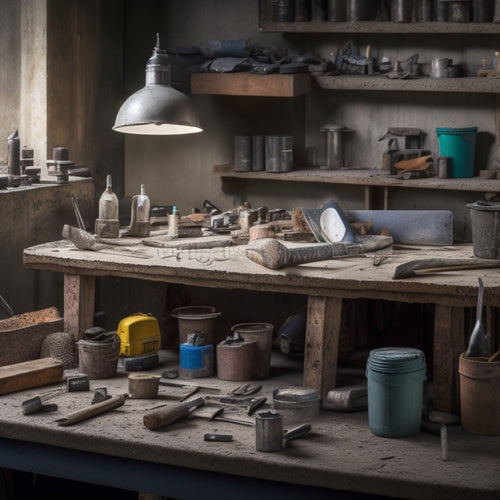
Top 5 Tools for Concrete Block Construction
Share
You'll need a combination of essential tools to secure a successful concrete block construction project. For tamping, a hand tamper, plate compactor, and jumping jack compactor are must-haves. A block saw and splitting hammer are vital for precise cuts and irregular shapes. A reliable mortar mixer and pointing trowel are necessary for efficient mixing and application. Additionally, a laser level and spirit level will guarantee accurate alignment and levelness. With these top 5 tools, you'll be well on your way to a structurally sound and visually appealing concrete block construction project - and that's just the foundation of what you can achieve.
Key Takeaways
• A hand tamper is essential for ensuring proper alignment and stability of concrete blocks during construction.
• A plate compactor is necessary for efficient compaction of large areas, especially in concrete block construction projects.
• A block saw or splitter is required for making precise cuts and achieving clean edges in concrete blocks.
• A reliable mortar mixer is vital for guaranteeing a consistent mix and efficient application of mortar.
• A laser level or spirit level is crucial for verifying the levelness and alignment of concrete blocks during construction.
Essential Tamping Tools for Block Laying
When laying concrete blocks, you'll need a set of essential tamping tools to guarantee proper alignment, levelness, and stability of the block structure. These tools will be your new best friends, helping you avoid wonky walls and uneven foundations.
The most important tamping tools include a hand tamper, plate compactor, and jumping jack compactor. Mastering tamping techniques is essential, as it makes certain the blocks are securely packed and aligned. Remember, a well-tamped block is a happy block!
Regular tool maintenance is also crucial to extend the lifespan of your tamping tools. Clean them thoroughly after each use, and perform routine checks for wear and tear. A rusty tamper is a sad tamper, and you don't want that to happen to you.
Block Cutting and Splitting Solutions
To achieve precise cuts and splits in concrete blocks, you'll need to employ the right tools and techniques, ensuring accurate fitting and minimizing waste.
When it comes to making straight cuts, block saws are the way to go. These powerful machines can slice through even the toughest blocks with ease, leaving a clean, precise edge.
But what about those tricky curved cuts or irregular shapes? That's where splitting hammers come in. With a few well-placed taps, you can split blocks along their natural lines, creating a seamless fit.
Mortar Mixing and Applying Tools
You'll need a reliable mortar mixer and a set of applicator tools to efficiently mix and place the right amount of mortar between your concrete blocks. A good mortar mixer will guarantee a consistent mix, saving you time and hassle. Look for one with adjustable speed and a large mixing capacity to handle big jobs.
When it comes to application, having the right tools makes all the difference. You'll need a pointing trowel for applying and shaping mortar, as well as a finishing trowel for smoothing out the surface. Don't forget a mortar hawk or board to hold and carry the mortar to your work area.
Practice your application techniques to guarantee a smooth, even spread. Remember, the key to a strong bond is the right amount of mortar in the right place.
With the right tools and a little practice, you'll be a pro at mixing and applying mortar in no time!
Leveling and Alignment Equipment
Leveling and Alignment Equipment
Frequently, verifying your concrete blocks are perfectly level and aligned is essential to maintaining structural integrity and preventing costly mistakes down the line. You don't want your structure to resemble the Leaning Tower of Pisa, do you? To achieve precision, you'll need the right tools. Here are some essentials to get you started:
| Tool | Purpose | Benefits |
|---|---|---|
| Laser Levels | Projects a level line or dot for accurate block placement | Guarantees consistent height, reduces errors |
| Alignment Stakes | Temporary markers for block alignment | Easy to set up, helps maintain straight lines |
| Spirit Levels | Verifies block levelness | Compact, portable, and inexpensive |
| String Lines | Creates a reference line for block alignment | Simple, yet effective, and budget-friendly |
When it comes to leveling and alignment, every fraction of an inch counts. With these tools, you'll be well on your way to building a structurally sound concrete block wall that'll make you proud. Remember, precision is key, and the right equipment will help you achieve it. So, don't skimp on these essentials – your structure's integrity depends on it!
Finishing and Pointing Accessories
Once your concrete block wall is built, it's time to focus on the finer details, ensuring a professional finish with the right finishing and pointing accessories. You'll need the perfect tools to get the job done efficiently and effectively.
For instance, grout bags are a must-have for filling gaps and joints between the blocks. These bags allow you to apply the right amount of pressure, ensuring a smooth finish without excess grout oozing out.
When it comes to pointing, a trowel set is your best friend. These sets usually include a variety of trowels in different sizes and shapes, perfect for scooping, spreading, and smoothing out the grout or mortar. Additionally, consider investing in a pointing trowel with a curved or angled blade, which helps you reach those tight spaces and corners.
Don't forget a grout float and a finishing trowel for a smooth, even finish. With these finishing and pointing accessories in your toolkit, you'll be well on your way to creating a professional-looking concrete block wall that's both functional and visually appealing.
Frequently Asked Questions
What Safety Gear Is Necessary for Concrete Block Construction?
When you're about to plunge into concrete block construction, don't forget to gear up!
You'll need safety goggles to protect those peepers from flying debris.
A good pair of gloves will also provide protection from abrasions and cuts.
And let's not forget about skin protection - wear long sleeves, pants, and a dust mask to prevent irritation.
You might look like a total geek, but trust us, it's worth it to avoid a world of hurt.
Can I Use a Laser Level for Indoor Block Construction?
You're about to commence an indoor concrete block construction adventure, and you're wondering if a laser level is your trusty compass.
Think of it as a precision-guided missile, ensuring accuracy and saving you from wonky walls.
For indoor construction techniques, a laser level is a game-changer, providing pinpoint accuracy and effortless layout.
Yes, you can definitely use a laser level for indoor block construction, and it'll make your life (and walls) straighter than a superhero's spine.
How Do I Prevent Blocks From Getting Damaged During Transportation?
When you're hauling concrete blocks, you don't want them to become damaged goods before they even reach the construction site.
To prevent this, you'll want to focus on transportation methods that prioritize block cushioning. You can use pallets with foam inserts or even old tires to create a soft landing for your blocks.
Are There Any Specific Storage Requirements for Concrete Blocks?
When storing concrete blocks, you'll want to safeguard them from soggy sabotage.
Silly as it sounds, sloppy storage can lead to moisture mayhem, weakening your blocks. To avoid this, focus on flawless block moisture control.
Confirm you're using the right block stacking methods, like staggered rows and adequate airflow, to prevent waterlogging.
Can I Use Concrete Blocks for Building a Curved Wall Structure?
You're thinking of building a curved wall structure with concrete blocks? That's a bold move!
While it's definitely doable, you'll need to master some specialized block wall techniques.
For a smooth curved wall design, you'll want to use a combination of radial blocks and specially cut blocks to achieve the desired curve.
Don't worry, it's not rocket science, but it does require some precision and patience.
With the right skills and planning, you'll be curving your way to a stunning structure in no time!
Conclusion
As you complete your concrete block construction project, remember that having the right tools is like being a master chef with a well-stocked kitchen - you can whip up a culinary masterpiece with ease.
Without them, you're left struggling to get the job done.
With these top 5 tools, you'll be building like a pro in no time.
In fact, a study by the Mason Contractors Association of America found that using the right tools can increase productivity by up to 20%.
Related Posts
-

What Tools to Rent for a Concrete Home Reno
When tackling a concrete home renovation, you'll need to rent a variety of specialized tools to get the job done. For...
-

Top DIY Concrete Grinding and Polishing Tools
When selecting DIY concrete grinding and polishing tools, you'll want to take into account a range of factors to guar...
-

Top Tools for Concrete Repair Success
When it comes to concrete repair success, you'll need a well-stocked toolkit with essential hand tools like trowels, ...


